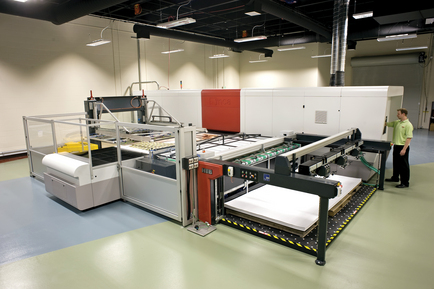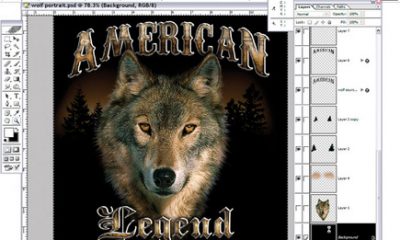The ability to accept short-run work and produce high-quality images without having to spend time preparing screens has driven an increasing number of graphics screen shops to consider investing in digital printing. Inkjet manufacturers have taken note. Over the past decade, they’ve continually added time-saving and production-enhancing functions to their equipment and simplified its use. But two factors still prove to be challenges for them: the effects of bi-directional printing and the inversely proportional relationship between printing speed and imaging resolution.
Large-format inkjet printers traditionally build images by scanning printheads back and forth across the substrate, a process that can create a banding effect. Banding also can be attributed to varying ink-droplet placement, the shape of the drops, and the differences caused by curing in each direction of printing. Meanwhile, the higher the imaging resolution, the slower the output. That’s because the printheads require additional time as they move across the substrate to jet inks with the extreme accuracy necessary to faithfully reproduce images at levels of quality appropriate for P-O-P applications and other display graphics intended for close-up viewing.
Inca Digital Printers equipped its Onset flatbed UV inkjet printer with new technologies that are designed to overcome the issues inherent to bi-directional printing and jump the hurdle of slower output at higher resolutions. The printer is stocked with 24 printhead modules, each of which contains 24 Dimatix printheads, across its print width for total of 73,728 inkjet nozzles that deliver a true resolution of 600 dpi. Inca says the printhead array can deliver three billion ink drops per second and, by providing full-width-print capability, it eliminates step-and-repeat banding. Each printhead module includes on-board electronics and data handling. The Onset uses those technologies to identify faulty nozzles and remap printing instructions to other nozzles to maintain expected print quality.
The Onset initially reached a top speed of 5382 sq ft/hr (500 sq m/hr), but a new bi-directional mode enables the printer to deliver throughput of up to 6458 sq ft/hr (600 sq m/hr) for graphics up to 10.5 x 5 ft (3.2 x 1.5 m). In effect, the Onset can print 375 posters measuring 60 x 40 in. (1524 x 1016 mm) in one hour.
A full vacuum table supports media up to 0.6 in. (15 mm) thick in manual print mode or 0.4 in. (10 mm) thick in automatic print mode. Manual mode facilitates one-off printing, while medium and long runs are best suited to automated material handling. The printer’s dual-UV-lamp curing system, front and rear, is designed to ensure that inks are completely cured under the lowest energy levels possible for the type of media in use. Additionally, operators can adjust the print finish between satin and gloss, depending on the print mode selected and media type.
The Onset uses Fujifilm Sericol’s Uvijet UV-curable inks. They’re specifically formulated to match the Onset’s productivity and expected range of applications. The inks incorporate Micro-V dispersion technology, which is designed to maximize pigment loading in Uvijet inks to achieve high color strength while maintaining ink stability and create a smaller particle size to prevent filter blockage and adverse effects on the printheads. Onset uses a four-color (CMYK) Uvijet inkset.
Other standard Onset features include immediate operator access for short runs, microadjustable height control, edge-to-edge and double-sided printing, and fixed dual registration points. The Inca Onset is available through Fujifilm Sericol USA Inc., 1101 W. Cambridge Dr., Kansas City, KS 66103, 913-342-4060, 800-255-4562, fax: 913-342-4752, e-mail: sericolinc@fujifilmsericol.com, Web: www.fujifilmsericol.com.

 Case Studies2 months ago
Case Studies2 months ago
 Art, Ad, or Alchemy2 months ago
Art, Ad, or Alchemy2 months ago
 Andy MacDougall2 months ago
Andy MacDougall2 months ago
 Columns3 weeks ago
Columns3 weeks ago
 Editor's Note3 weeks ago
Editor's Note3 weeks ago
 Marshall Atkinson3 weeks ago
Marshall Atkinson3 weeks ago
 Thomas Trimingham2 months ago
Thomas Trimingham2 months ago
 Case Studies3 weeks ago
Case Studies3 weeks ago








